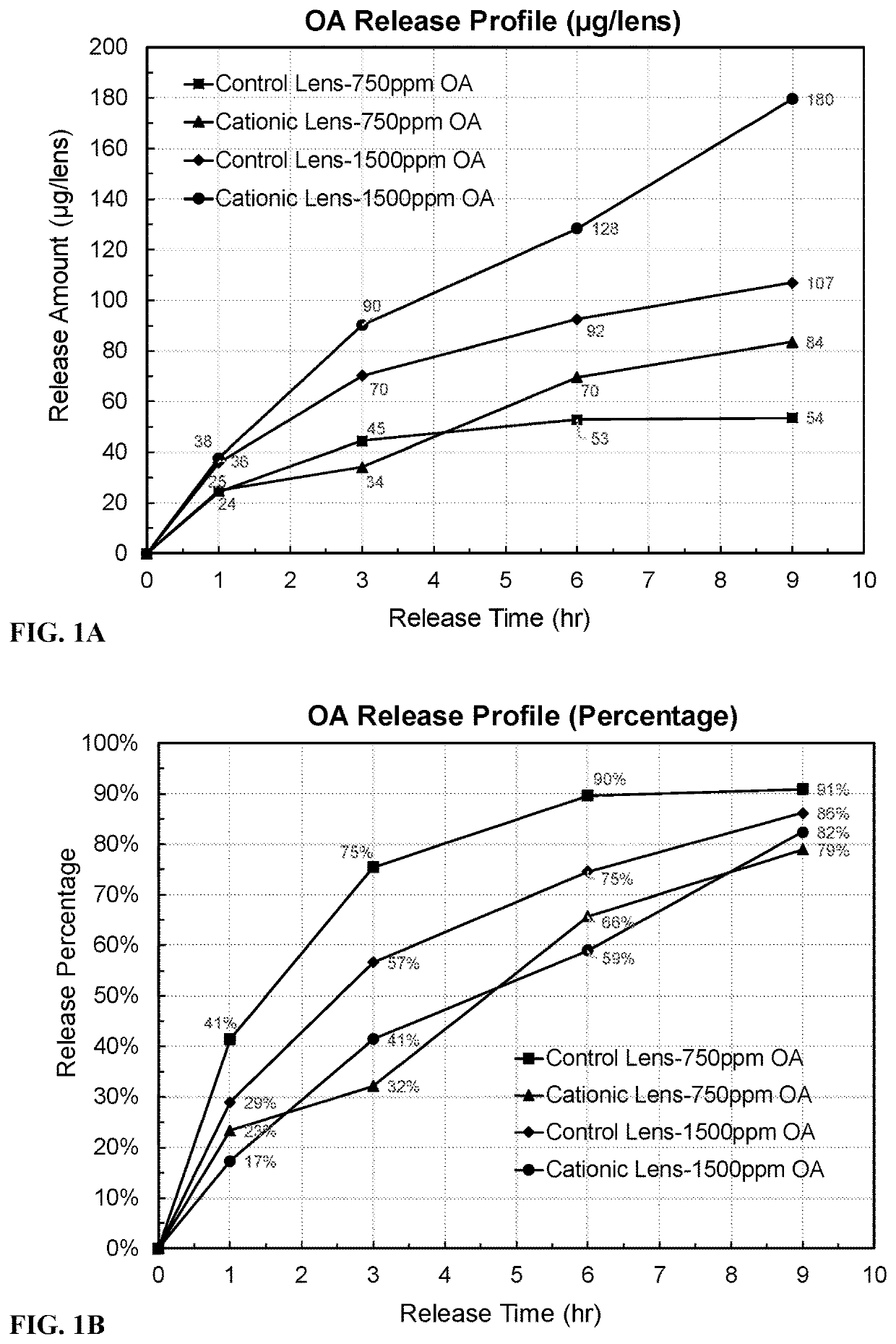Cationic contact lens
a contact lens and cationic technology, applied in the field of contact lenses and sealed contact lens packages, to avoid a burst release of comfort agents
- Summary
- Abstract
- Description
- Claims
- Application Information
AI Technical Summary
Benefits of technology
Problems solved by technology
Method used
Image
Examples
example 1
d Uptake from a Cationic Silicone Hydrogel Lens
[0089]Silicone hydrogel contact lenses were prepared using the polymerizable composition for stenfilcon A (control lenses) or stenfilcon A modified to contain about 4.5 wt. % 2-(dimethylamino)ethyl methacrylate (cationic lenses). The polymerizable compositions were cured in polypropylene contact lens molds. The polymeric lens bodies were removed from the molds and extracted by immersing them for 215 minutes in ethanol (EtOH) containing oleic acid (Sigma) in the concentrations shown in Table I. The lenses were removed from the EtOH and washed in a mixture of 50 / 50 (by vol) EtOH / water for approximately 30 minutes followed by three exchanges of DI water for approximately 6 minutes, 30 minutes, and 30 minutes, respectively.
[0090]The amount of oleic acid (OA) in each lens (n=3) was determined by extracting the lens with isopropanol (IPA) and measuring oleic acid in the extract by liquid chromatography-mass spectrometry (LCMS). Briefly, each ...
example 2
d Release from a Cationic Silicone Hydrogel Lens
[0091]An artificial tear film (ATF) having the composition shown in Table 2 was used as an in vitro release media.
TABLE 2ConcentrationComponent(mg / L)Sodium chloride5259.8Potassium chloride1192.8Sodium citrate441.09Glucose36.032Urea72.072Calcium chloride55.49Sodium carbonate1271.88Potassium hydrogen carbonate300.33Sodium phosphate dibasic3407.04Bovine Serum Albumin (fatty Acid-free)2000Lysozyme from chicken egg white1900Mucin from bovine submaxillary glands150DI Water1 LHydrochloric acid (10 molar, 37%)pH 7.1-7.2
[0092]Each lens was removed from its container and shaken to remove excess packaging solution. Each lens (n=3) was transferred to a 6 mL glass vial and 5 mL of ATS pre-warmed to 35° C. was added to each vial. The vials were placed in a 35° C. incubator and shaken at 125 rpm. The release media was exchanged with 4.5 mL fresh ATS at 1, 3, and 7 hours. The amount of oleic acid in the lens at each time point was determined using the...
PUM
| Property | Measurement | Unit |
|---|---|---|
| wt. % | aaaaa | aaaaa |
| time | aaaaa | aaaaa |
| pH | aaaaa | aaaaa |
Abstract
Description
Claims
Application Information
 Login to View More
Login to View More - R&D
- Intellectual Property
- Life Sciences
- Materials
- Tech Scout
- Unparalleled Data Quality
- Higher Quality Content
- 60% Fewer Hallucinations
Browse by: Latest US Patents, China's latest patents, Technical Efficacy Thesaurus, Application Domain, Technology Topic, Popular Technical Reports.
© 2025 PatSnap. All rights reserved.Legal|Privacy policy|Modern Slavery Act Transparency Statement|Sitemap|About US| Contact US: help@patsnap.com

